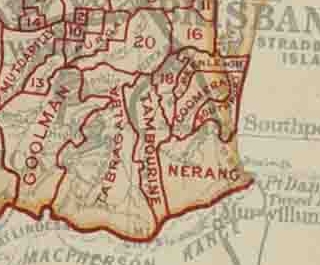1902 to 1916


The Federation Drought began in 1895 and reached its peak in 1901 and 1902 across eastern Australia, particularly worse in Queensland which received almost no rain until December of 1902. As a result, Australian sheep numbers fell from 91 to 54 million, and cattle numbers fell from 11.8 to 7 million, with rabbit numbers increasing to plague proportions. The severe drought reduced Thomas Plunkett’s dairy herd to just eleven head, forcing him to restock his herd with 90 head of Jersey heifers purchased from the Northern Rivers region for £5 per head. Unpredictable weather made farming extremely difficult in the region, with the following observations were made about the environment at the time: “Sometimes, the river stopped running altogether and during winter it iced over as temperatures dipped to -6°C. Heavy frosts also killed paddock grasses forcing locals to take bullock wagons over the mountain to the Hope Island area where they harvested blady grass to keep the animals alive.”
With the passage of the Local Authorities Act 1902, the Tambourine Division became the Shire of Tambourine on 31 March 1903.
Lahey’s Canungra Tramway opened in September 1903. Ownership of Biddaddaba then passed to the Persse family in 1904. The Witches Falls section, on the eastern side of Mount Tamborine, became Queensland’s First National Park in 1908.
In 1909, the Tambourine Provisional School became the Tambourine State School. When Thomas Plunkett died in 1913, responsibility for the dairy passed to his second youngest son, Walter Edward Plunkett. His son, Walter Edward (Paul) Plunkett, recalls milking five cows by hand before walking to school.
Dairy, timber and even sugar were becoming major industries in the region and in order to improve transportation of produce, an inspection of the proposed railway route from Logan Village to Canungra was carried out by the Premier, The Honourable William Kidston and his Ministers in 1910. Two days were set aside to complete the journey. A special train was organised to travel to Logan Village where the ministers were met by Councillors of the Tambourine Shire Council Cr. Alfred W. C. Henderson (Chairman of Tambourine Shire), and Councillors A. G. Hinds, S. Thompson, and Mr. David Lahey. Messrs. J. Stodart, M.L.A., C. Campbell, and A. Kibble arrived by an earlier train and all were entertained at a luncheon. After lunch the visitors were driven over the proposed route by way of Steele’s Track. The main Beenleigh-Tambourine Road was crossed and a course was taken through the paddocks of Mr. A. Henderson until the Albert River was reached. Here a crossing of the high bank was effected on foot by the aid of a rustic bridge which had been built over Steel’s Falls.” The party noted that first 6 to 7 miles of the trip were considered to be “second-class land”, but thought the “Albert River at this spot was to be most picturesque”. Afternoon tea was enjoyed at Mr. Henderson’s residence, then the party passed through Tambourine regretting they could not call on Mr. T. Plunkett at the time. The junction of the Jimboomba and Logan Village roads was eventually reached, the party arriving later at the township of Canungra (“Canungera”) gaily decorated with flags and bunting by the schoolchildren. The following morning, the Premier was “astonished to see the Canungra tramway” and noted the potential for opening up the lush area for both timber and tourism. After lunch, visitors rushed to meet the Jimboomba train for the journey home. A survey was later approved in 1911, for the construction of commencement of the new railway section.
In December of 1913, a terrible drowning tragedy happened in Tambourine with four lives lost at a spot in the Albert River known as Steel’s Falls in the immediate vicinity of the construction of the Canungra railway bridge. The accident occurred near the residence of Councillor Alfred Henderson where he sadly lost his wife, two daughters, Jessie and Elsie aged 19 and 17 years respectively, and Miss Doris Wilcox, their girl friend who was a nurse at the Children’s Hospital in Brisbane. Unfortunately they had forgotten to take a sealed kerosene can to aid in their flotation while learning to swim. While waiting for friend, Mrs J Dunn, to return with the tin, one had possibly accidentally slipped down the sharp bank into the depths, with the others, unable to swim, rushing to her aid and all sadly drowning.
When Tamborine Mountain was opened up to land selection in 1875, the population remained quite small over the years and only started to increase in 1914 from the five families on the northern end of the mountain to become enough to “start a dancing club”.
The railway line was finally completed from Logan Village through Plunkett and Tambourine Stations to Broomfleet in March and through Boyland, Wonglepong and Benobble Stations to Canungra in July of 1915. Essentially for freight, occasional Sunday ‘excursions’ were made to Canungra on passenger trains carrying up to 400 people from Tambourine and surrounds. The Plunkett Station was located on the north bank of the Albert River within the current suburb of Yarrabilba (behind TankRide), and the Tambourine Station was located near the centre of town (close to St Patrick’s Catholic Church’s current location).
At this time, Canungra had become a significant township serving a large area along the Canungra Creek and upper Coomera River region. When the Canungra Branch Railway Line opened, the Lahey family built the Bellissima Guest House in 1916 to accommodate people overnight doing business with the Canungra Sawmill.
